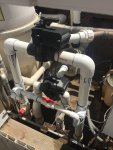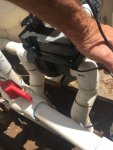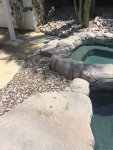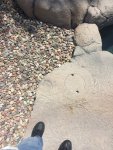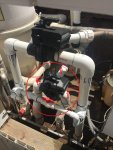Hello Folks,
I believe we have an underground suction leak somewhere between the skimmer basket and the pump. I'll describe what I've done to determine that and post some pictures. Please jump in if I am headed down the wrong path. Thank you in advance. And now the backstory...
I replaced all the above ground "O" rings in the various pieces of equipment and still had lots of air bubbles in the pump basket. I ran a garden hose over all the fittings and "O" rings to see if that would help. It didn't, but besides the air bubbles in the basket pump everything was functioning properly. The following morning, the pump automatically shutdown shortly after startup when prime wasn't achieved. I reset the pump and re-started the motor. After a few minutes I could see that it wasn't going to prime so I shut it down. I pulled the in-pool skimmer basket out, removed the cover plate and shoved a garden hose (fully on) down the inlet hole, re-started the motor and no luck. She wouldn't prime. Turned the motor off, pulled the hose out and re-configured the valves to isolate the pool skimmer out of the system. So now (I think) the pump will only get it's water from the spa. I turn the motor on, it primes right away and only one small air bubble in the pump basket. Success!
I switch the valves back to the pool while everything is running and it holds, except for a lot of air bubbles. Next morning same problem at start up. I switch the valves to the spa everything works great.
Now the questions...before I start digging everything up.
Does this mean we have an underground suction leak somewhere between the skimmer and the pool pump?
If yes, should I expect to find underground a "Y" coupler where the pipe from the pool skimmer connects to the pipe from the spa and only one pipe runs to the pump, or do pool builders run two separate pipes (one for the spa and one for the pool)? My thought is if it's just one pipe I'll replace all the pipe from the spa to the skimmer and be done with it.
Is there an easier way to fix this without digging everything up?
Thanks,
Mike
I believe we have an underground suction leak somewhere between the skimmer basket and the pump. I'll describe what I've done to determine that and post some pictures. Please jump in if I am headed down the wrong path. Thank you in advance. And now the backstory...
I replaced all the above ground "O" rings in the various pieces of equipment and still had lots of air bubbles in the pump basket. I ran a garden hose over all the fittings and "O" rings to see if that would help. It didn't, but besides the air bubbles in the basket pump everything was functioning properly. The following morning, the pump automatically shutdown shortly after startup when prime wasn't achieved. I reset the pump and re-started the motor. After a few minutes I could see that it wasn't going to prime so I shut it down. I pulled the in-pool skimmer basket out, removed the cover plate and shoved a garden hose (fully on) down the inlet hole, re-started the motor and no luck. She wouldn't prime. Turned the motor off, pulled the hose out and re-configured the valves to isolate the pool skimmer out of the system. So now (I think) the pump will only get it's water from the spa. I turn the motor on, it primes right away and only one small air bubble in the pump basket. Success!
I switch the valves back to the pool while everything is running and it holds, except for a lot of air bubbles. Next morning same problem at start up. I switch the valves to the spa everything works great.
Now the questions...before I start digging everything up.
Does this mean we have an underground suction leak somewhere between the skimmer and the pool pump?
If yes, should I expect to find underground a "Y" coupler where the pipe from the pool skimmer connects to the pipe from the spa and only one pipe runs to the pump, or do pool builders run two separate pipes (one for the spa and one for the pool)? My thought is if it's just one pipe I'll replace all the pipe from the spa to the skimmer and be done with it.
Is there an easier way to fix this without digging everything up?
Thanks,
Mike


